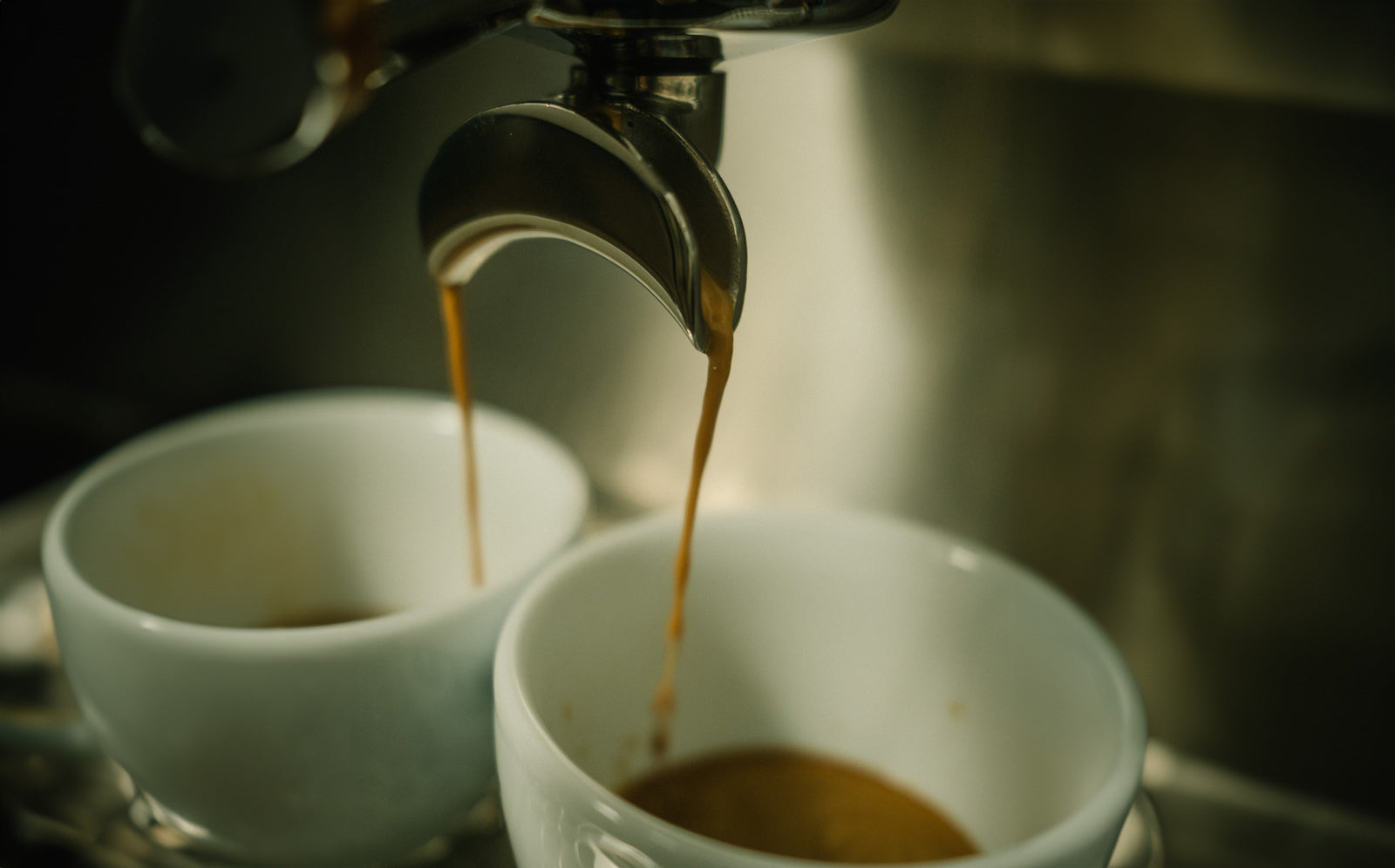So if you love espresso, ristretto, doppio, lungo and cappuccino - then you need a portafilter machine. Why? It is the perfect espresso machine. Espresso only came into being when the portafilter machine was invented. And vice versa. There are a few other methods of making espresso today... but the original is the portafilter espresso. Here you can find out everything about the portafilter, the portafilter machine and the alternatives.
Portafilter Espresso – how the machine works
The important components for your portafilter machine to function properly and make you a great espresso include the finely ground coffee beans, which are then compressed (tamped) in the portafilter. Once the portafilter is clamped into the machine, the following happens: The machine heats the water to 88 to 96 degrees Celsius and then presses it through the previously compressed coffee grounds at high pressure, at least 9 bar. The pressure is the most important thing here. Because, here is a brief glossary: Espresso doesn’t just come from the Italian word for express, which refers to the short brewing time of 25 to 30 seconds. Espresso is also the past participle of esprimere , which means to express. And this is where the connection to pressure comes in: if you don’t have enough pressure, you can’t express/brew a good espresso.
Which portafilters are there?
The portafilter machines available on the market can be roughly divided into professional machines and home machines. However, no one is prohibited from putting professional machines in their own home for a good chunk of money. The question is always: what do I really need? Decide for yourself based on functionality and budget.
thermoblock machines

These machines are compact portafilter machines for a small budget of up to 500 euros. The thermoblock is a continuous flow heater that makes the machine ready for use quickly. The disadvantage of this machine is that the temperature fluctuates quite a bit. The advantage is that you can prepare espresso quickly.
single-circuit
Single-circuit portafilter machines have a water circuit and a boiler - for the coffee and the steam. And that is also the disadvantage. If you want a cappuccino, you need more time because you have to froth and prepare the espresso one after the other. The advantage, however, is a very precise and constant temperature. These machines do cost a little more.
dual-circuit system
As the name suggests, dual-circuit machines have two water circuits - one for making coffee and one for steam and hot water. With a large boiler, you also have sufficiently stable temperatures for brewing and frothing. The disadvantage of these machines is that you have to dig a lot deeper into your pockets.
From here on, things only get more professional and more expensive. There are also machines with multiple boilers and even more circuits. The question is how much coffee you need in a short space of time. Normally, you should be able to manage with one of the machines mentioned above for your home. If you have a café or a restaurant, then it's a little different, but we'd rather give you individual advice. Take a look here.
portafilter vs fully automatic
Of course, there are other methods of making espresso these days. The most common is the fully automatic machine. The fully automatic machine is a marvel of modern laziness and technology. All-in-one is the motto here. Whether it's espresso, latte macchiato, hot water for tea and all the rest - it's all just a push of a button away. And yes, there are fully automatic machines today that make pretty good espresso. But always remember: Even when fully automatic machines advertise 15 to 19 bar pressure, that is usually the maximum possible pump pressure. However, for a good espresso, the brewing pressure is important and this is usually below the maximum possible pressure. In addition, espresso doesn't like it when too much pressure is used. A pressure between 9 and 11 bar is optimal.
But basically both machines work in a similar way: water is heated, pressure is built up, ground coffee is compressed and the water is pressed through - milk may also be frothed. The big difference is that with portafilter espresso most of the work is done by hand and the fully automatic machine does everything for you.
Portafilter Espresso – other ways of preparation
And then there are other methods to make "espresso". It is in quotation marks because the following methods are recognized and relatively functional, but only produce espresso to a limited extent.
stovetop kettle or Bialetti
You won't find one in any Italian household: the stovetop kettle, also known as a Bialetti. Here, too, hot water is pressed through fine coffee grounds under pressure. The standard version of such a stovetop kettle can generate a maximum of 1.5 bar of pressure, which gives you a good coffee but not the crema needed for an espresso. Even the models with a valve can reach perhaps 2 bar of pressure.
Aeropress with Prismo attachment
Fellow has the Prismo attachment for the Aeropress. This also allows you to make espresso with the Aeropress. But even here, when using it manually, you can hardly reach the 9 bar pressure at which an espresso feels good. Nevertheless, you can still get a pretty good espresso, usually without crema.
There are also many other hand-operated espresso machines that we have no experience with, but even here it will almost certainly not be a full replacement for a portafilter espresso.
Portafilter espresso – why does it taste best from the portafilter?
The answer is actually quite simple: because you have full control over all the variables that can affect the taste of your espresso, both positively and negatively. You can set the optimal grind level on your grinder and finely adjust it if something changes in the beans. You can set the temperature (especially on better machines) to one decimal place. You have precise control over the brewing time, you can weigh the exact amount of coffee used beforehand and much more. The portafilter machine also generates the required 9 to 11 bar of pressure. Modern fully automatic machines can do this too, but the equally important factors of quantity, grind level and brewing time etc. are often beyond your control.

Portafilter Espresso – Step-by-Step Instructions
- Weigh the right amount of coffee: 19 grams for a double shot
- Grind beans finely and place in a clean portafilter
- Distribute the coffee evenly in the sieve (leveler, WDT tool etc.) and compact it with a tamper (caution: risk of channeling)
- Briefly rinse the brewing group (flush) and then clamp the portafilter
- Place the cup underneath and start the brewing process, which should take between 25 and 30 seconds
If your espresso runs too quickly, adjust the grind setting a little finer.
If it runs too slowly, grind it more coarsely.
If your espresso tastes too sour, grind it finer.
If it tastes too bitter, grind it more coarsely.
If the coffee puck is too wet, use more coffee.
If it is too dry, use less coffee.
Portafilter Espresso – Innovations in this area
The espresso sector has not stood still since its invention. There are always new inventions and improvements. Let's take a quick look at two of them now.
Portafilter Espresso – Heylo
Heylo is an Italian company that has developed new types of portafilter machines. New in the sense that you can save many different profiles. This means that the machine remembers how to extract the espresso with a certain bean. You can also set a temperature curve. This means that you can start the extraction of your espresso at 93 degrees, for example, then increase it to 95 degrees and finally drop it to 88 degrees. The advantage of this is that you have the optimal temperature for each extraction phase (acidity, sweetness, bitterness). This makes your espresso even better.
Espresso Waving
Another new discovery is espresso waving. It is already known that you should move or mix your espresso after extraction so that the extraction phases mentioned above mix and the portafilter espresso tastes even more balanced. Espresso waving takes this mixing to a new level. Your espresso is not just stirred, but mixed with vibrations. Felix Hohlmann from the coffee makers discovered and researched this method; you can find a video about it here.
Portafilter Espresso – Conclusion
An espresso is not only the epitome of Italian coffee culture, but also a very popular drink worldwide. Whether with or without a shot, shortened or extended, and without a doubt one of the most popular coffee drinks of all with a topping of milk foam. There are many ways to make an espresso, the best - in our opinion - is and remains the portafilter.


